Utilizing Urban Geospatial Data to Understand Heritage Attractiveness in Amsterdam
Abstract
:1. Introduction
2. Data and Methods
2.1. Data Collection and Preparation
2.2. Cluster Analysis
2.3. Estimation of Heritage’s Attractiveness
3. Results
3.1. Cluster Analysis
3.2. Identifying Attractive Heritages
3.3. Estimation of Heritage Attractiveness
3.3.1. The Results of Global Model (OLS)
3.3.2. The Results of Local Model (GWR)
3.3.3. Model Performance
4. Conclusions
5. Discussion
Author Contributions
Funding
Acknowledgments
Conflicts of Interest
Appendix A
| Attribute | Explanation | Attribute | Explanation |
|---|---|---|---|
| latitude * | Photo’s latitude | url * | Photo’s URL |
| longitude * | Photo’s longitude | join date | User’s join time |
| owner * | Photo’s identifier | occupation | User’s occupation of |
| date_taken * | Photo’s taken time | hometown | User’s hometown of |
| date_unknown * | Unknown taken time | first_name | User’s name |
| date_uploaded * | Photo’s upload time | last_name | User’s last name |
| title | Photo’s title | website | User’s personal website |
| description | Photo’s description | city | User’s city |
| tags | Photo’s tags | country | User’s country |
| Year | Tourist | Local | Total |
|---|---|---|---|
| 2007 and earlier | 197 | 830 | 1027 |
| 2008 | 165 | 336 | 501 |
| 2009 | 298 | 499 | 797 |
| 2010 | 330 | 644 | 974 |
| 2011 | 274 | 800 | 1074 |
| 2012 | 140 | 906 | 1046 |
| 2013 | 674 | 1634 | 2308 |
| 2014 | 964 | 1576 | 2540 |
| 2015 | 710 | 4686 | 5396 |
| 2016 | 732 | 2970 | 3702 |
| 2017 | 2107 | 2252 | 4359 |
| 2018 | 5092 | 5289 | 10,381 |
| 2019 | 1083 | 3023 | 4106 |
| Grand total | 12,766 | 25,445 | 38,211 |
Appendix B
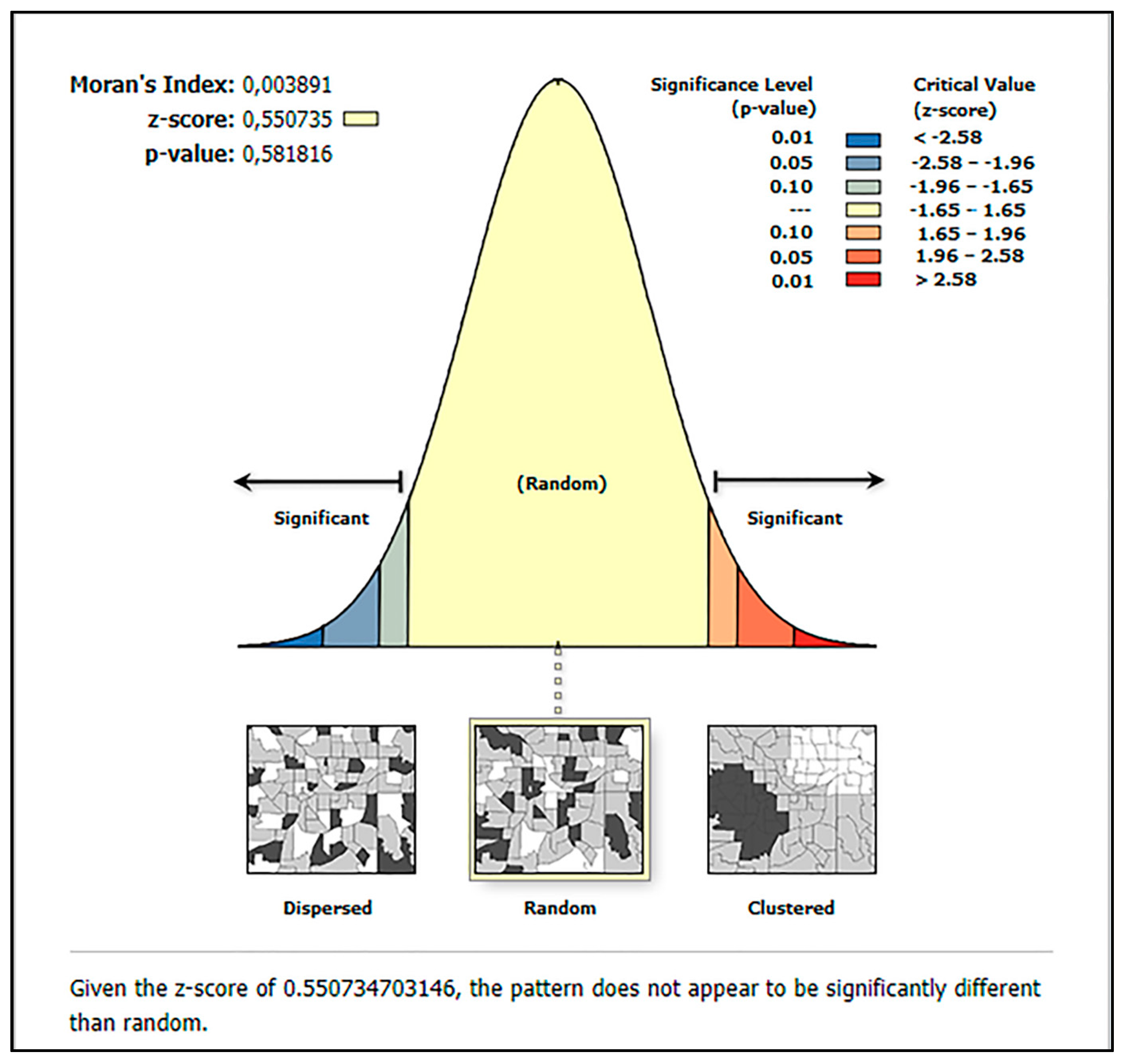
| Diagnose Name | Value | Definition |
|---|---|---|
| AIC | 1499.96782597000 | Akaike’s information criterion: a relative measure of performance used to compare models; the smaller AIC indicates the superior model. |
| AICc | 1500.63449263000 | Corrected Akaike’s information criterion: second-order correction for small sample sizes. |
| R2 | 0.39725686606 | R-Squared, coefficient of determination: the proportion of variation in the dependent variable that is explained by the model. |
| AdjR2 | 0.38443254406 | Adjusted R-squared: R-squared adjusted for model complexity (number of variables) as it relates to the data. |
| F-Stat | 30.97683184330 | Joint F-statistic value: used to assess overall model significance. |
| F-Prob | 0.00000000000 | Joint F-statistic probability (p-value): the probability that none of the explanatory variables have an effect on the dependent variable. |
| Wald | 29.45291722620 | Wald statistic: used to assess overall robust model significance. |
| Wald-Prob | 0.00105205020 | Wald statistic probability (p-value): the computed probability, using robust standard errors, that none of the explanatory variables have an effect on the dependent variable. |
| K(BP) | 172.61536356700 | Koenker’s studentized Breusch–Pagan statistic: used to test the reliability of standard error values when heteroskedasticity (nonconstant variance) is present. |
| K(BP)-Prob | 0.00000000000 | Koenker (BP) statistic probability (p-value): the probability that heteroskedasticity (nonconstant variance) has not made standard errors unreliable. |
| JB | 73438.08015430000 | Jarque–Bera statistic: used to determine whether the residuals deviate from a normal distribution. |
| JB-Prob | 0.00000000000 | Jarque–Bera probability (p-value): the probability that the residuals are normally distributed. |
| Sigma2 | 1.28891101535 | Sigma-squared: OLS estimate of the variance of the error term (residuals). |
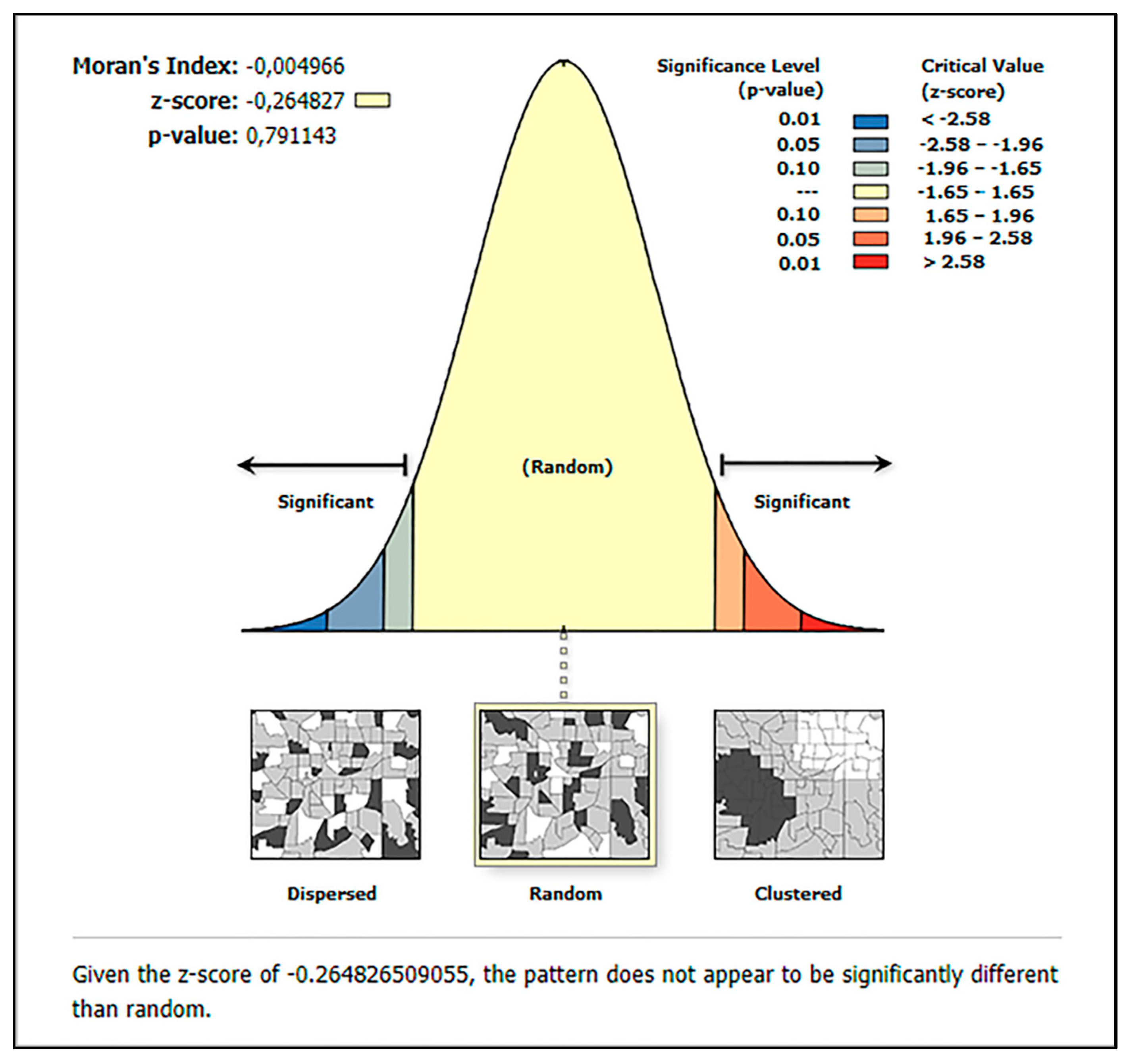
| Diagnostic Name | Value |
|---|---|
| Neighbors | 103.00000000000 |
| Residual squares | 266.63162555400 |
| Effective number | 109.62242880200 |
| Sigma | 0.84732104742 |
| AICc | 1292.70285212000 |
| R2 | 0.73470861988 |
| R2Adjusted | 0.65711482778 |
References
- van der Borg, J.; Costa, P.; Gotti, G. Tourism in European Heritage Cities. Ann. Tour. Res. 1996, 23, 306–321. [Google Scholar] [CrossRef]
- García-Hernández, M.; de la Calle-Vaquero, M.; Yubero, C. Cultural Heritage and Urban Tourism: Historic City Centres under Pressure. Sustainability 2017, 9, 1346. [Google Scholar] [CrossRef] [Green Version]
- van der Zee, E.; Bertocchi, D.; Vanneste, D. Distribution of Tourists within Urban Heritage Destinations: A Hot Spot/Cold Spot Analysis of TripAdvisor Data as Support for Destination Management. Curr. Issues Tour. 2018, 1–22. [Google Scholar] [CrossRef] [Green Version]
- Ashworth, G.; Page, S.J. Urban Tourism Research: Recent Progress and Current Paradoxes. Tour. Manag. 2011, 32, 1–15. [Google Scholar] [CrossRef]
- Tu, H.-M. Sustainable Heritage Management: Exploring Dimensions of Pull and Push Factors. Sustainability 2020, 12, 8219. [Google Scholar] [CrossRef]
- Li, Y.; Lo, R.L.B. Applicability of the Market Appeal—Robusticity Matrix: A Case Study of Heritage Tourism. Tour. Manag. 2004, 25, 789–800. [Google Scholar] [CrossRef]
- Trinh, T.T.; Ryan, C. Visitors to Heritage Sites: Motives and Involvement—A Model and Textual Analysis. J. Travel Res. 2017, 56, 67–80. [Google Scholar] [CrossRef]
- Song, H.; Liu, H. Predicting Tourist Demand Using Big Data. In Analytics in Smart Tourism Design; Xiang, Z., Fesenmaier, D.R., Eds.; Springer International Publishing: Cham, Switzerland, 2017; pp. 13–29. ISBN 978-3-319-44262-4. [Google Scholar]
- Laney, D. 3D Data Management Controlling Data Volume Velocity and Variety. META Group Res. Note 2001, 6, 1. [Google Scholar]
- Beyer, M.; Laney, D. The Importance of “Big Data”: A Definition; Gartner: Stamford, CT, USA, 2012; Available online: https://www.gartner.com/en/documents/2057415/the-importance-of-big-data-a-definition (accessed on 31 December 2020).
- Li, G. Big data related technologies, challenges and future prospects. Inf. Technol. Tourism 2015, 15, 283–285. [Google Scholar] [CrossRef]
- Karayazi, S.S.; Dane, G.; de Vries, B. Leveraging Newly Available Big Data for Urban Architectural Heritage: Designing a Recommendation System for Heritage Sites through the Lens of Social Media. In Real Corp 2020: Shaping Urban Change Livable City Regions for the 21st Century, Proceedings of 25th International Conference on Urban Planning, Regional Development and Information Society, 1st ed.; Schereng, M., Popovich, V.V., Zeile, P., Elisei, P., Beyer, C., Ryser, J., Reicher, C., Eds.; RWTH-Aachen University: Aachen, Germany, 2020; pp. 553–563. ISBN 978-3-9504173-9-5. [Google Scholar]
- Kádár, B. Measuring Tourist Activities in Cities Using Geotagged Photography. Tour. Geogr. 2014, 16, 88–104. [Google Scholar] [CrossRef]
- Ginzarly, M.; Pereira Roders, A.; Teller, J. Mapping Historic Urban Landscape Values through Social Media. J. Cult. Herit. 2018. [Google Scholar] [CrossRef]
- Koutras, A.; Nikas, I.A.; Panagopoulos, A. Towards Developing Smart Cities: Evidence from GIS Analysis on Tourists’ Behavior Using Social Network Data in the City of Athens. In Smart Tourism as a Driver for Culture and Sustainability; Katsoni, V., Segarra-Oña, M., Eds.; Springer International Publishing: Cham, Switzerland, 2019; pp. 407–418. ISBN 978-3-030-03909-7. [Google Scholar]
- Devkota, B.; Miyazaki, H.; Pahari, N. Utilizing User Generated Contents to Describe Tourism Areas of Interest. In Proceedings of the 2019 First International Conference on Smart Technology & Urban Development (STUD), Chiang Mai, Thailand, 13–14 December 2019; pp. 1–6. [Google Scholar]
- García-Palomares, J.C.; Gutiérrez, J.; Mínguez, C. Identification of Tourist Hot Spots Based on Social Networks: A Comparative Analysis of European Metropolises Using Photo-Sharing Services and GIS. Appl. Geogr. 2015, 63, 408–417. [Google Scholar] [CrossRef]
- Ganzaroli, A.; De Noni, I.; van Baalen, P. Vicious Advice: Analyzing the Impact of TripAdvisor on the Quality of Restaurants as Part of the Cultural Heritage of Venice. Tour. Manag. 2017, 61, 501–510. [Google Scholar] [CrossRef]
- Girardin, F.; Vaccari, A.; Gerber, A.; Biderman, A. Quantifying Urban Attractiveness from the Distribution and Density of Digital Footprints. Int. J. Spat. Data Infrastruct. Res. 2009, 4, 26. [Google Scholar]
- Gede, M.; Kádár, B. Analysing Tourism Movements along the Danube River Based on Geotagged Flickr Photography. Proc. Int. Cartogr. Assoc. 2019, 2, 1–5. [Google Scholar] [CrossRef]
- Runge, C.A.; Daigle, R.M.; Hausner, V.H. Quantifying Tourism Booms and the Increasing Footprint in the Arctic with Social Media Data. PLoS ONE 2020, 15, e0227189. [Google Scholar] [CrossRef] [Green Version]
- Gong, V.X.; Daamen, W.; Bozzon, A.; Hoogendoorn, S.P. Crowd Characterization for Crowd Management Using Social Media Data in City Events. Travel Behav. Soc. 2020, 20, 192–212. [Google Scholar] [CrossRef]
- Dane, G.; Borgers, A.; Kaya, D.I.; Feng, T. Visitor Flows at a Large-Scale Cultural Event: GPS Tracking at Dutch Design Week. IJGI 2020, 9, 661. [Google Scholar] [CrossRef]
- Shoval, N.; Ahas, R. The Use of Tracking Technologies in Tourism Research: The First Decade. Tour. Geogr. 2016, 18, 587–606. [Google Scholar] [CrossRef]
- Duca, L.; Marchetti, A. Open data for tourism: The case of Tourpedia. J. Hosp. Tour. Technol. 2018, 10, 351–368. [Google Scholar]
- Vong, L.T.-N.; Ung, A. Exploring Critical Factors of Macau’s Heritage Tourism: What Heritage Tourists Are Looking for When Visiting the City’s Iconic Heritage Sites. Asia Pac. J. Tour. Res. 2012, 17, 231–245. [Google Scholar] [CrossRef]
- Dane, G.; Borgers, A.; Feng, T. Subjective Immediate Experiences during Large-Scale Cultural Events in Cities: A Geotagging Experiment. Sustainability 2019, 11, 5698. [Google Scholar] [CrossRef] [Green Version]
- Paldino, S.; Bojic, I.; Sobolevsky, S.; Ratti, C.; González, M.C. Urban Magnetism through the Lens of Geo-Tagged Photography. EPJ Data Sci. 2015, 4, 5. [Google Scholar] [CrossRef] [Green Version]
- Ministerie van Onderwijs, C. en W. Rijksmonumenten-kaartlagen-Rijksmonumenten register-Rijksdienst voor het Cultureel Erfgoed. Available online: https://www.cultureelerfgoed.nl/onderwerpen/rijksmonumentenregister/rijksmonumenten-kaartlagen (accessed on 31 August 2020).
- Data En Informatie-Amsterdam. Available online: https://data.amsterdam.nl/ (accessed on 31 August 2020).
- Centre, U.W.H. Seventeenth-Century Canal Ring Area of Amsterdam inside the Singelgracht. Available online: https://whc.unesco.org/en/list/1349/ (accessed on 26 December 2020).
- Macqueen, J. Some Methods for Classification and Analysis of Multivariate Observations. Multivar. Obs. 1967, 1, 17. [Google Scholar]
- Lee, I.; Cai, G.; Lee, K. Exploration of Geo-Tagged Photos through Data Mining Approaches. Expert Syst. Appl. 2014, 41, 397–405. [Google Scholar] [CrossRef]
- Dunn, J.C. A Fuzzy Relative of the ISODATA Process and Its Use in Detecting Compact Well-Separated Clusters. Null 1973, 3, 32–57. [Google Scholar] [CrossRef]
- Mai, D.S.; Ngo, L.T. Semi-Supervised Fuzzy C-Means Clustering for Change Detection from Multispectral Satellite Image. In Proceedings of the 2015 IEEE International Conference on Fuzzy Systems (FUZZ-IEEE), Istanbul, Turkey, 2–5 August 2015; pp. 1–8. [Google Scholar]
- Winkler, R.; Klawonn, F.; Kruse, R. Problems of Fuzzy c-Means Clustering and Similar Algorithms with High Dimensional Data Sets. In Challenges at the Interface of Data Analysis, Computer Science, and Optimization; Gaul, W.A., Geyer-Schulz, A., Schmidt-Thieme, L., Kunze, J., Eds.; Springer: Berlin/Heidelberg, Germany, 2012; pp. 79–87. ISBN 978-3-642-24465-0. [Google Scholar]
- Kisilevich, S.; Krstajic, M.; Keim, D.; Andrienko, N.; Andrienko, G. Event-Based Analysis of People’s Activities and Behavior Using Flickr and Panoramio Geotagged Photo Collections. In Proceedings of the 2010 14th International Conference Information Visualisation, London, UK, 26–29 July 2010; pp. 289–296. [Google Scholar]
- Ester, M.; Kriegel, H.-P.; Xu, X. A Density-Based Algorithm for Discovering Clusters in Large Spatial Databases with Noise. In Proceedings of the Second International Conference on Knowledge Discovery and Data Mining (KDD-96), Portland, OR, USA, 2–4 August 1996; Volume 96, pp. 226–231. [Google Scholar]
- Batra Nagpal, P.; Ahlawat Mann, P. Comparative Study of Density Based Clustering Algorithms. Int. J. Comput. Appl. 2011, 27, 44–47. [Google Scholar] [CrossRef]
- Götz, M.; Bodenstein, C.; Riedel, M. HPDBSCAN: Highly Parallel DBSCAN. In Proceedings of the Workshop on Machine Learning in High-Performance Computing Environments-MLHPC ’15, Austin, TX, USA, 15–20 November 2015; 2015; pp. 1–10. [Google Scholar]
- Kempiak, J.; Hollywood, L.; Bolan, P.; McMahon-Beattie, U. The Heritage Tourist: An Understanding of the Visitor Experience at Heritage Attractions. Int. J. Herit. Stud. 2017, 23, 375–392. [Google Scholar] [CrossRef]
- Brunsdon, C.; Fotheringham, S.; Charlton, M. Geographically Weighted Regression-Modelling Spatial Non-Stationarity. J. R. Stat. Soc. Ser. D 1998, 47, 431–443. [Google Scholar] [CrossRef]
- Wooldridge, J.M. Introductory Econometrics: A Modern Approach. Nelson Educ. 2012, 910, 94–99. [Google Scholar]
- Statistiek, C.B. voor de Wijk-En Buurtkaart. 2020. Available online: https://www.cbs.nl/nl-nl/dossier/nederland-regionaal/geografische-data/wijk-en-buurtkaart-2020 (accessed on 3 November 2020).
- Moran, P.A.P. Notes on Continuous Stochastic Phenomena. Biometrika 1950, 37, 7. [Google Scholar] [CrossRef]
- Fu, W.J.; Jiang, P.K.; Zhou, G.M.; Zhao, K.L. Using Moran’s I and GIS to Study the Spatial Pattern of Forest Litter Carbon Density in a Subtropical Region of Southeastern China. Biogeosciences 2014, 11, 2401–2409. [Google Scholar] [CrossRef] [Green Version]
- How OLS Regression Works—ArcGIS Pro | Documentation. Available online: https://pro.arcgis.com/en/pro-app/tool-reference/spatial-statistics/how-ols-regression-works.htm (accessed on 19 November 2020).
- Akaike, H. Information Theory and an Extension of the Maximum Likelihood Principle. In Selected Papers of Hirotugu Akaike; Parzen, E., Tanabe, K., Kitagawa, G., Eds.; Springer: New York, NY, USA, 1998; pp. 199–213. ISBN 978-1-4612-1694-0. [Google Scholar]
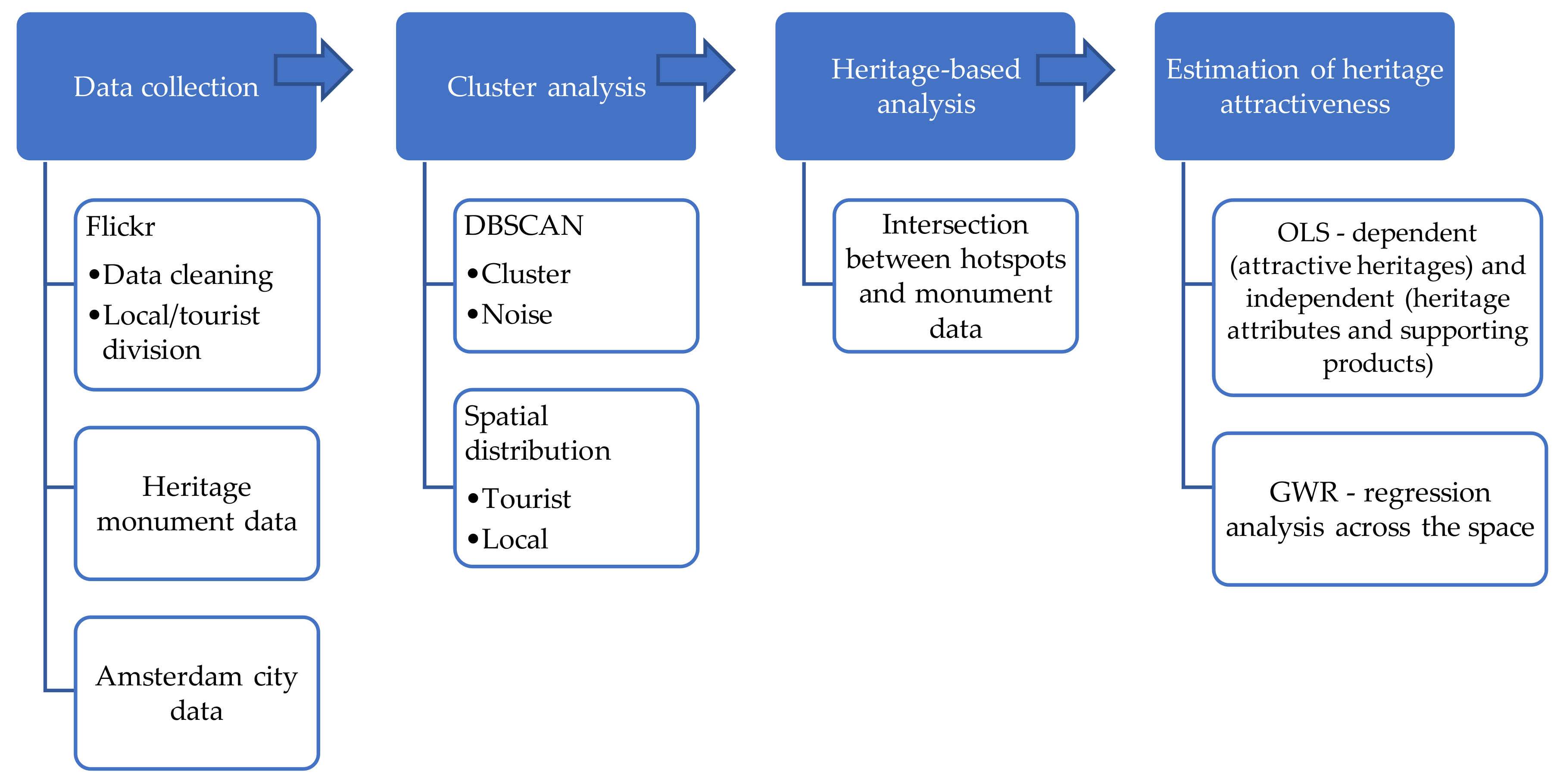
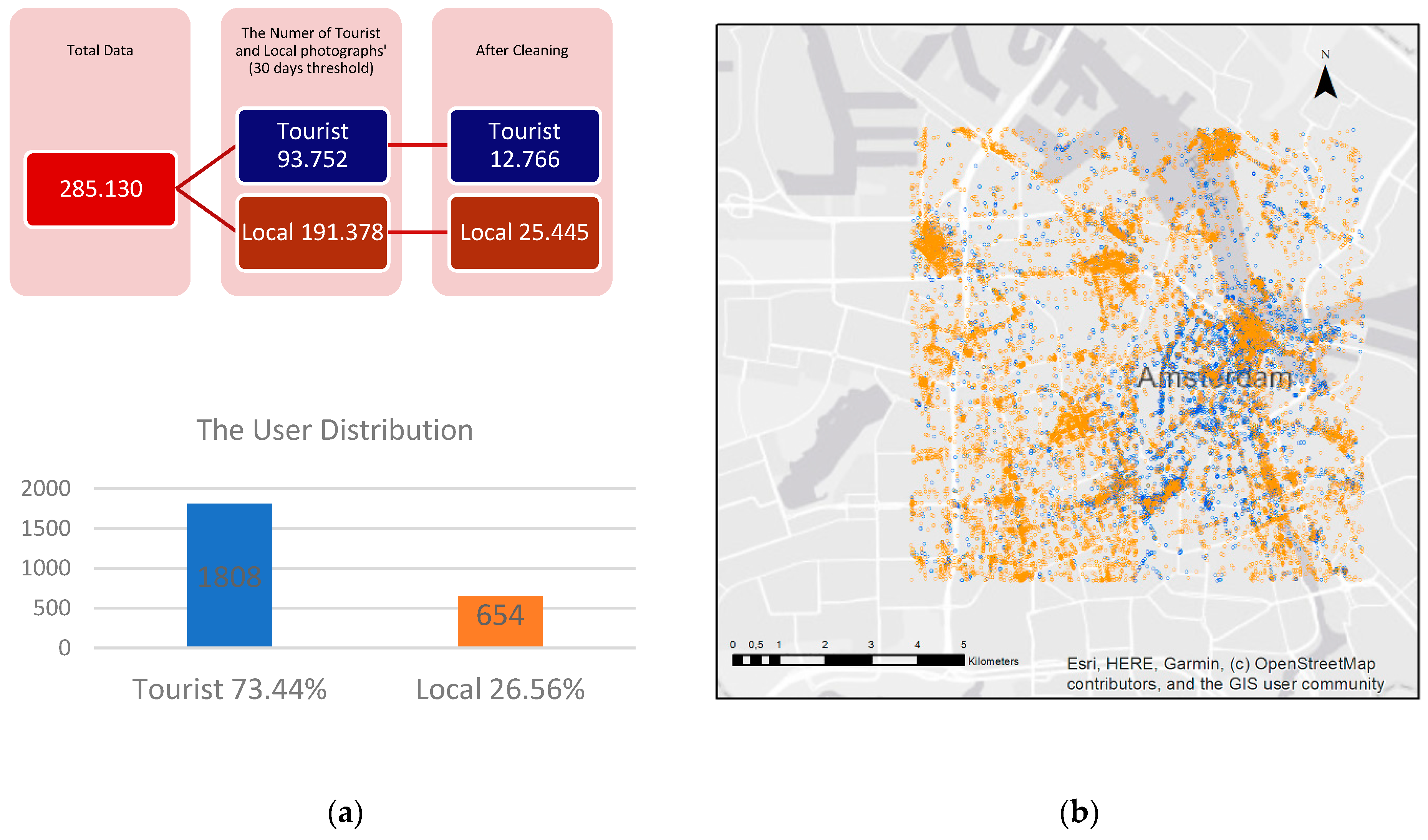
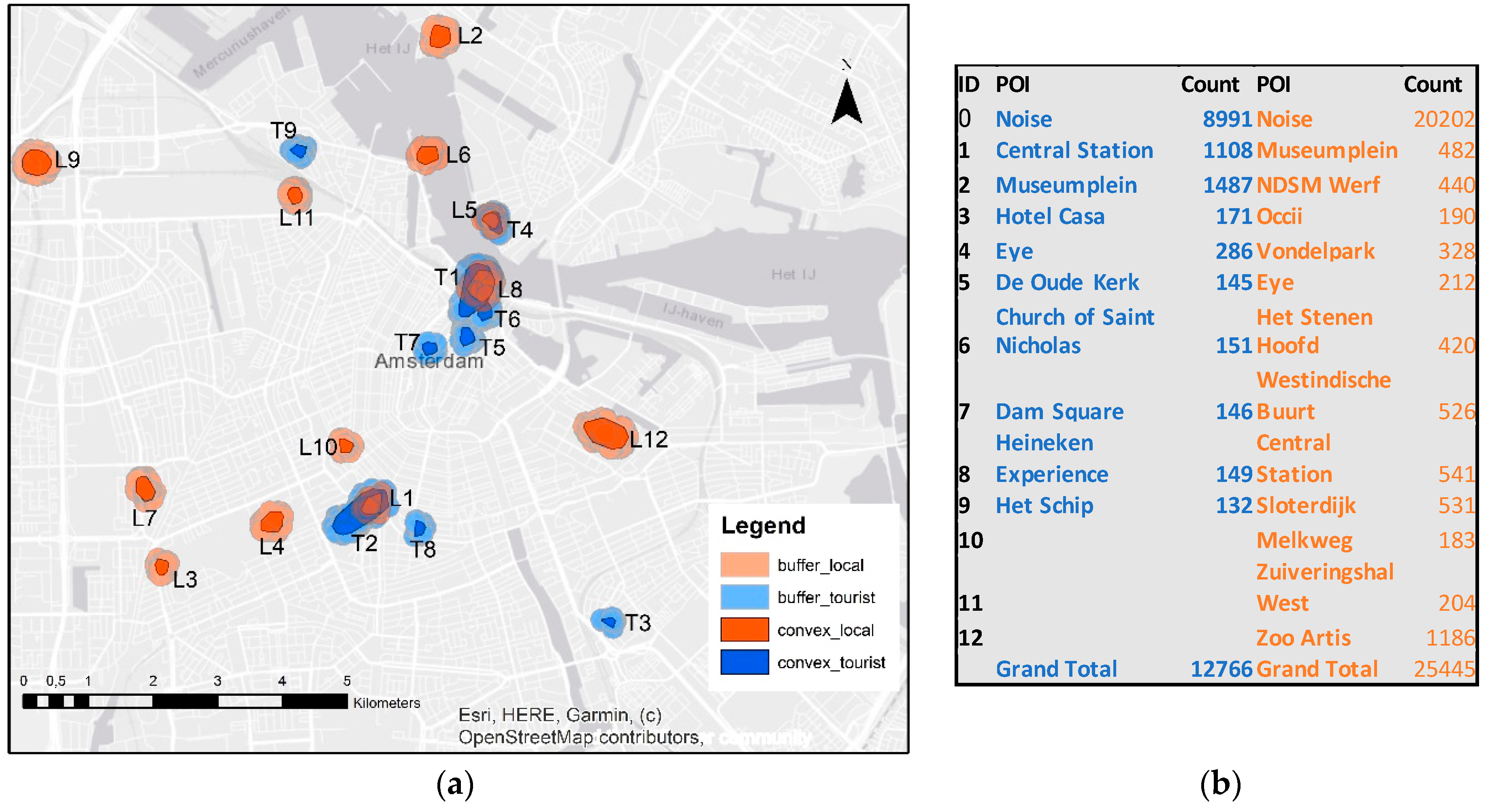




| Heritage Type | Group |
|---|---|
| Catering | Catering |
| Church | Church |
| Education | Education |
| House | House |
| Industry | Industry |
| Shopping | Shopping |
| Storage | Storage |
| Transportation | Transportation |
| Uncategorized | Uncategorized |
| Office building | Office |
| Garden and park | Garden and zoo |
| Zoo | |
| Administration building | Governmental building |
| Court | |
| Governmental building | |
| Military | |
| Service home | |
| Social care | |
| Fort/fortress | Remains |
| Housing part | |
| Memorial | |
| Remains | |
| Street furniture | |
| Art and culture | Culture and sport |
| Sport and recreation |
| Culture and Science | Commercial and Governmental | Recreation |
|---|---|---|
| Church | Governmental building | Catering |
| Culture and sport | Industry | Garden, park and zoo |
| Education | Shopping | |
| Storage | ||
| Transportation | ||
| Office building |
| Variables | Mean | Standard Deviation | Minimum | Maximum | VIF |
|---|---|---|---|---|---|
| Attractive heritage | 0.25 | 1.447 | 0 | 18 | - |
| Commercial | 1.16 | 4.645 | 0 | 54 | 1.495 |
| Recreation | 0.17 | 0.971 | 0 | 16 | 1.217 |
| Residential | 10.53 | 36.857 | 0 | 371 | 3.076 |
| Attraction | 0.68 | 1.527 | 0 | 12 | 4.216 |
| Eating | 1.31 | 2.885 | 0 | 31 | 2.231 |
| Museum | 0.25 | 0.802 | 0 | 6 | 3.251 |
| Open market | 0.09 | 0.373 | 0 | 3 | 1.186 |
| Public toilet | 0.38 | 1.001 | 0 | 10 | 1.313 |
| Shopping Tram-metro stops | 1.21 0.18 | 4.047 0.507 | 0 0 | 57 4 | 2.713 1.338 |
| Coefficients | Estimate | Std. Error | t-Statistics | Probability 1 |
|---|---|---|---|---|
| Intercept | −0.011 | 0.059 | −1.851 | 0.064 |
| Commercial | 0.115 | 0.013 | 8.455 | 0.000 *** |
| Recreation | 0.417 | 0.058 | 7.086 | 0.000 *** |
| Residential | −0.002 | 0.002 | −0.911 | 0.362 |
| Attraction | 0.273 | 0.069 | 3.927 | 0.000 *** |
| Eating | 0.048 | 0.026 | 1.800 | 0.072 * |
| Museum | −0.093 | 0.116 | −0.800 | 0.423 |
| Open market | −0.410 | 0.151 | −2.715 | 0.006 *** |
| Public toilet | 0.149 | 0.059 | 2.513 | 0.012 ** |
| Shopping Tram metro stops | −0.085 0.201 | 0.021 0.120 | −4.055 1.673 | 0.000 *** 0.094 * |
| Model | R2 | Adjusted R2 | AICc | RSS |
|---|---|---|---|---|
| OLS | 0.397 | 0.384 | 1500.634 | 605.788 |
| GWR | 0.734 | 0.657 | 1297.702 | 266.631 |
Publisher’s Note: MDPI stays neutral with regard to jurisdictional claims in published maps and institutional affiliations. |
© 2021 by the authors. Licensee MDPI, Basel, Switzerland. This article is an open access article distributed under the terms and conditions of the Creative Commons Attribution (CC BY) license (http://creativecommons.org/licenses/by/4.0/).
Share and Cite
Karayazi, S.S.; Dane, G.; Vries, B.d. Utilizing Urban Geospatial Data to Understand Heritage Attractiveness in Amsterdam. ISPRS Int. J. Geo-Inf. 2021, 10, 198. https://doi.org/10.3390/ijgi10040198
Karayazi SS, Dane G, Vries Bd. Utilizing Urban Geospatial Data to Understand Heritage Attractiveness in Amsterdam. ISPRS International Journal of Geo-Information. 2021; 10(4):198. https://doi.org/10.3390/ijgi10040198
Chicago/Turabian StyleKarayazi, Sevim Sezi, Gamze Dane, and Bauke de Vries. 2021. "Utilizing Urban Geospatial Data to Understand Heritage Attractiveness in Amsterdam" ISPRS International Journal of Geo-Information 10, no. 4: 198. https://doi.org/10.3390/ijgi10040198
APA StyleKarayazi, S. S., Dane, G., & Vries, B. d. (2021). Utilizing Urban Geospatial Data to Understand Heritage Attractiveness in Amsterdam. ISPRS International Journal of Geo-Information, 10(4), 198. https://doi.org/10.3390/ijgi10040198








